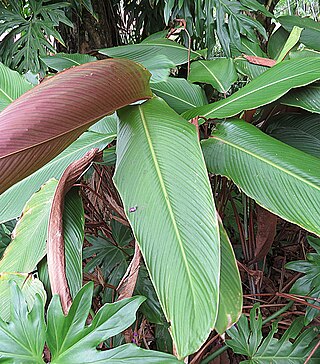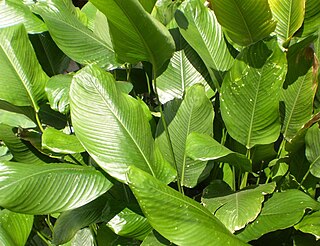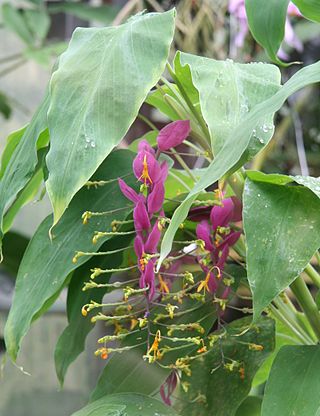Hunteria is a genus of plants in the family Apocynaceae first described as a genus in 1824. It is native to Africa and to South and Southeast Asia.
- Hunteria ballayiHua - Central African Republic, Republic of Congo, Cameroon, Gabon
- Hunteria camerunensisK.Schum. ex Hallier f. - Republic of Congo, Cameroon, Gabon
- Hunteria congolanaPichon - Republic of Congo, Zaïre, Kenya
- Hunteria densifloraPichon - Zaïre
- Hunteria ghanensisJ.B.Hall & Leeuwenb. - Ivory Coast, Ghana
- Hunteria hexaloba(Pichon) Omino - Gabon
- Hunteria macrosiphonOmino - Republic of Congo, Gabon
- Hunteria myrianthaOmino - Zaïre
- Hunteria oxyanthaOmino - Republic of Congo, Zaïre, Gabon
- Hunteria simii(Stapf) H.Huber - Guinea, Ivory Coast, Liberia, Sierra Leone
- Hunteria umbellata(K.Schum) Hallier f. - W + C Africa from Senegal to Zaïre
- Hunteria zeylanica(Retz.) Gardner ex Thwaites - Somalia, Kenya, Tanzania, Mozambique, S China, India, Sri Lanka, Andaman & Nicobar Islands, Indochina, W Malaysia, Sumatra

Renealmia is a plant genus in the family Zingiberaceae. Its members are native to tropical Africa and tropical America. In Peru, fruits and tubers are sources of indigenous dyes. and indigenous medical treatments for leishmania and malaria In Colombia, it is used to treat snakebite. Bracts and leaves can serve as phytotelmata, retaining small quantities of water that offer habitat for other organisms.

Maranta is a genus of flowering plants in the family Marantaceae, native to tropical Central and South America and the West Indies. Maranta was named for Bartolomeo Maranta, an Italian physician and botanist of the sixteenth century.

Sciaphila is a genus of mycoheterotrophic plants in the family Triuridaceae. These plants receive nutrition from fungi and neighboring trees and have less need for photosynthesis. It is widespread in tropical and subtropical regions, found in Africa, China, Japan, the Indian Subcontinent, Southeast Asia, Latin America and on various islands Pacific Islands. The most noteworthy feature of the genus is the number of the various flower parts 99.9 percent of Monocots are trimerous, but Sciaphila spp. can have eight or even ten parts in a whorl.
Cuviera is a genus of flowering plants in the family Rubiaceae native to tropical Africa. It was originally described by Augustin Pyramus de Candolle in 1807 and is named after the French naturalist Georges Cuvier.

Craterispermum is a genus of flowering plants in the family Rubiaceae. It contains 16 species that occur in tropical Africa and Seychelles. It is the only genus in the tribe Craterispermeae, of which the divergence time is estimated at 34.8 million years ago.

Alafia is a genus of lianas or climbing shrubs found in tropical Africa and Madagascar. The World Checklist of Selected Plant Families recognises 26 species:

Baissea is a genus of plant in the family Apocynaceae found in tropical Africa. As of August 2013 the World Checklist of Selected Plant Families recognises 18 species:
Oncinotis is a genus of plant in the family Apocynaceae, first described as a genus in 1849. It is native to Africa, including Madagascar. As of August 2013 the World Checklist of Selected Plant Families recognises 7 species:
- Oncinotis glabrata(Baill.) Stapf ex Hiern - tropical Africa from Liberia to Tanzania, south to Angola
- Oncinotis gracilisStapf - tropical Africa from Liberia to Central African Republic, south to Angola
- Oncinotis hirtaOliv. - C Africa from Cameroon to Angola
- Oncinotis nitidaBenth. - W Africa from Liberia to Republic of Congo
- Oncinotis pontyiDubard - tropical Africa from Guinea to Uganda
- Oncinotis tenuilobaStapf - C + S Africa from Nigeria east to Sudan + Ethiopia, south to Cape Province
- Oncinotis tomentellaRadlk. - Madagascar
- Oncinotis axillarisK.Schum. = Baissea multifloraA.DC.
- Oncinotis campanulataK.Schum = Baissea campanulata(K.Schum.) de Kruif
- Oncinotis melanocephalaK.Schum. = Baissea myrtifolia(Benth.) Pichon
- Oncinotis subsessilisK.Schum. = Baissea campanulata(K.Schum.) de Kruif
- Oncinotis zygodioidesK.Schum. = Baissea zygodioides(K.Schum.) Stapf

Pleiocarpa is a genus of plant in the family Apocynaceae first described as a genus in 1876. It is native to tropical Africa from Senegal to Tanzania and south to Zimbabwe. As of August 2013 the World Checklist of Selected Plant Families recognises 6 species:
- Pleiocarpa bicarpellataStapf - Cabinda, Cameroon, Republic of the Congo, Gabon, Democratic Republic of the Congo, Kenya
- Pleiocarpa brevistylaOmino - Gabon
- Pleiocarpa muticaBenth. - Ghana, Ivory Coast, Liberia, Sierra Leone, Nigeria, Cameroon, Gabon, Central African Republic, Republic of the Congo
- Pleiocarpa picralimoides(Pichon) Omino - Cabinda, Republic of the Congo, Gabon
- Pleiocarpa pycnantha(K.Schum) Stapf - widespread across most of tropical Africa
- Pleiocarpa rostrataBenth. - Nigeria, Cameroon, Gabon
- Pleiocarpa camerunensis(K.Schum. ex Hallier f.) Stapf = Hunteria camerunensisK.Schum. ex Hallier f.
- Pleiocarpa hockiiDe Wild. - Acokanthera oppositifolia(Lam.) Codd
- Pleiocarpa simii(Stapf) Stapf ex Hutch. & Dalziel = Hunteria simii(Stapf) H.Huber
Halopegia is a genus of plants native to tropical Africa, Madagascar, and tropical southeast Asia. Three species are recognized as of April 2014:
Monophyllanthe is a genus of plants native to Brazil, Colombia, French Guinea and Suriname. It contains 2 recognized species:

Pleiostachya is a genus of plants in the Marantaceae family native to Mexico, Central America, Colombia, and Ecuador. It contains 3 recognized species:

Stachyphrynium is a genus of plants native to China, the Indian Subcontinent, and Southeast Asia. It was first described as a genus with this name in 1902.

Elettariopsis was a genus of plants in the ginger family, that has now been subsumed into the genus Amomum. Species are native to Southeast Asia, southern China and New Guinea.

Hornstedtia is a genus of plants in the Zingiberaceae. It is native to Southeast Asia, the Himalayas, southern China, New Guinea, Melanesia and Queensland.

Boesenbergia is a genus of plants in the ginger family. It contains more than 90 species, native to China, the Indian Subcontinent, and Southeast Asia.
Gagnepainia is a genus of plants in the ginger family, Zingiberaceae. It has three known species, all native to Indochina. All three were initially described in 1895 as members of Hemiorchis, then transferred to the newly created Gagnepainia in 1904.

Globba is a genus of plants in the ginger family. It contains about 100 species, native to China, the Indian Subcontinent, Southeast Asia, New Guinea, the Bismarck Archipelago and Queensland.
Schlechterella is a genus of plants in the family Apocynaceae. It is native to Africa, found in Ethiopia, Kenya, Mozambique, Somalia, Tanzania and Uganda.













